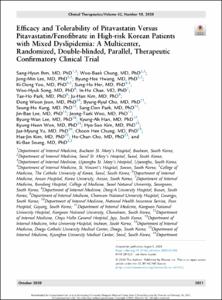KUMEL Repository
1. Journal Papers (연구논문)
1. School of Medicine (의과대학)
Dept. of Internal Medicine (내과학)
Efficacy and Tolerability of Pitavastatin Versus Pitavastatin/Fenofibrate in High-risk Korean Patients with Mixed Dyslipidemia: A Multicenter, Randomized, Double-blinded, Parallel, Therapeutic Confirmatory Clinical Trial
- Affiliated Author(s)
- 조호찬
- Alternative Author(s)
- Cho, Ho Chan
- Journal Title
- Clinical therapeutics
- ISSN
- 1879-114X
- Issued Date
- 2020
- Keyword
- cardiovascular disease; dyslipidemia; fenofibrate; nonehigh-density lipoprotein cholesterol; pitavastatin
- Abstract
- Purpose:
Dyslipidemia is an important risk factor for cardiovascular disease (CVD). Statins are known to effectively reduce not only low-density lipoprotein cholesterol (LDL-C) level but also death and nonfatal myocardial infarction due to coronary heart disease. The risk for CVD from atherogenic dyslipidemia persists when elevated triglyceride (TG) and reduced high-density lipoprotein cholesterol (HDL-C) levels are not controlled with statin therapy. Therefore, statin/fenofibrate combination therapy is more effective in reducing CVD risk. Here, we assessed the efficacy and tolerability of pitavastatin/fenofibrate combination therapy in patients with mixed dyslipidemia and a high risk for CVD.
Methods:
This multicenter, randomized, double-blind, parallel-group, therapeutic-confirmatory clinical trial evaluated the efficacy and tolerability of fixed-dose combination therapy with pitavastatin/fenofibrate 2/160 mg in Korean patients with a high risk for CVD and a controlled LDL-C level (<100 mg/dL) and a TG level of 150–500 mg/dL after a run-in period with pitavastatin 2 mg alone. In the 8-week main study, 347 eligible patients were randomly assigned to receive pitavastatin 2 mg with or without fenofibrate 160 mg after a run-in period. In the extension study, patients with controlled LDL-C and non–HDL-C (<130 mg/dL) levels were included after the completion of the main study. All participants in the extension study received the pitavastatin/fenofibrate combination therapy for 16 weeks for the assessment of the tolerability of long-term treatment.
Findings:
The difference in the mean percentage change in non–HDL-C from baseline to week 8 between the combination therapy and monotherapy groups was −12.45% (95% CI, −17.18 to −7.72), and the combination therapy was associated with a greater reduction in non-HDL-C. The changes in lipid profile, including apolipoproteins, fibrinogen, and high-sensitivity C-reactive protein from baseline to weeks 4 and 8 were statistically significant with combination therapy compared to monotherapy at all time points. Furthermore, the rates of achievement of non–HDL-C and apolipoprotein B targets at week 8 in the combination therapy and monotherapy groups were 88.30% versus 77.98% ( P = 0.0110) and 78.94% versus 68.45% ( P = 0.0021), respectively. The combination therapy was well tolerated, with a safety profile similar to that of statin monotherapy.
Implications:
In these Korean patients with mixed dyslipidemia and a high risk for CVD, combination therapy with pitavastatin/fenofibrate was associated with a greater reduction in non–HDL-C compared with that with pitavastatin monotherapy, and a significantly improvement in other lipid levels. Moreover, the combination therapy was well tolerated, with a safety profile similar to that of statin monotherapy. Therefore, pitavastatin/fenofibrate combination therapy could be effective and well tolerated in patients with mixed dyslipidemia. ClinicalTrials.gov identifier: NCT03618797 .
- Department
- Dept. of Internal Medicine (내과학)
- Publisher
- School of Medicine (의과대학)
- Citation
- Sang-Hyun Ihm et al. (2020). Efficacy and Tolerability of Pitavastatin Versus Pitavastatin/Fenofibrate in High-risk Korean Patients with Mixed Dyslipidemia: A Multicenter, Randomized, Double-blinded, Parallel, Therapeutic Confirmatory Clinical Trial. Clinical therapeutics, 42(10), 2021–2035. doi: 10.1016/j.clinthera.2020.08.002
- Type
- Article
- ISSN
- 1879-114X
- Appears in Collections:
- 1. School of Medicine (의과대학) > Dept. of Internal Medicine (내과학)
- 파일 목록
-
-
Download
 oak-2020-0274.pdf
기타 데이터 / 681.13 kB / Adobe PDF
oak-2020-0274.pdf
기타 데이터 / 681.13 kB / Adobe PDF
-
Items in Repository are protected by copyright, with all rights reserved, unless otherwise indicated.